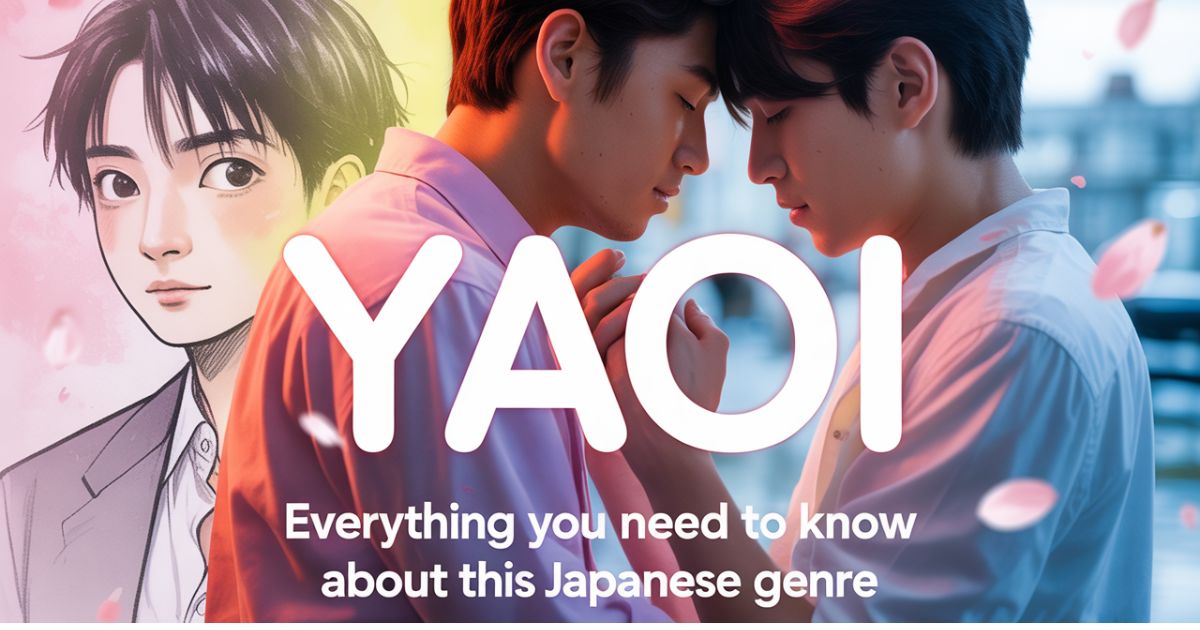Yaoi has captivated millions worldwide, yet many still wonder what this Japanese cultural phenomenon actually represents.
Whether you’re encountering the term for the first time or seeking deeper understanding, this comprehensive guide unpacks everything from origins to modern-day significance. Let’s explore this fascinating genre that’s reshaped how audiences engage with romantic storytelling.
What Does Yaoi Actually Mean? Breaking Down the Term
Yaoi originates from a Japanese acronym “Yama nashi, ochi nashi, imi nashi” which translates roughly to “no climax, no point, no meaning.”
Sounds contradictory, right? The term initially emerged as self-deprecating humor among early creators who viewed their work as plotless romantic content.
However, the genre evolved far beyond its tongue-in-cheek beginnings. Today, yaoi specifically refers to male-male romantic or sexual content created primarily by women, for women.
The terminology carries significant weight in fan communities. Unlike clinical or academic labels, yaoi represents grassroots creativity that flourished outside mainstream publishing channels.
You’ll encounter variations like “Boys’ Love” or “BL” which technically differ from yaoi in subtle but meaningful ways we’ll explore shortly.
Understanding this linguistic foundation helps you navigate conversations within fan spaces where terminology matters deeply to community members.
The Fascinating Origins: How Yaoi Emerged from Japanese Fan Culture
The yaoi movement began in the 1970s within Japan’s dōjinshi (self-published works) scene.
Female manga enthusiasts started creating alternative storylines featuring male characters from popular series like Captain Tsubasa and Saint Seiya in romantic scenarios.
These weren’t officially sanctioned stories. They represented fan interpretations that explored emotional dynamics mainstream publishers wouldn’t touch.
Comiket, Japan’s massive comic convention, became ground zero for yaoi distribution. Creators sold photocopied booklets directly to audiences hungry for content reflecting their interests.
The 1980s witnessed explosive growth. Series like JUNE magazine legitimized the genre by providing professional publication venues for what began as amateur passion projects.
By the 1990s, yaoi had established distinct artistic styles, narrative conventions, and devoted readership that publishers could no longer ignore.
Fast forward to 2025, and the genre commands entire publishing imprints, streaming platforms, and international fan conventions generating millions in economic activity.
Yaoi vs. BL (Boys’ Love): Understanding the Key Differences That Matter
Here’s where things get nuanced. Many people use yaoi and BL interchangeably, but devoted fans recognize important distinctions.
BL (Boys’ Love) serves as the broader umbrella term encompassing all male-male romantic content in Japanese media.
Yaoi specifically refers to sexually explicit content, often with less emphasis on plot development or character depth.
Think of it this way: all yaoi falls under BL, but not all BL qualifies as yaoi.
Shōnen-ai represents another subset—romantic male relationships without explicit sexual content, focusing instead on emotional connection and tension.
Professional Japanese publishers typically market content as “BL” to encompass wider audience appeal and varying maturity levels.
The term yaoi has somewhat fallen out of favor in Japan itself, replaced by the more respectable “BL” designation as the genre gained mainstream acceptance.
Western audiences, however, still frequently use yaoi, particularly when discussing older works or explicitly sexual content.
According to a 2023 survey by MyAnimeList, approximately 68% of English-speaking fans use “yaoi” and “BL” without distinguishing between them.
Why Is Yaoi So Popular? The Psychology Behind Its Global Fanbase
The yaoi phenomenon puzzles many observers. Why do predominantly heterosexual women consume male-male romantic content so voraciously?
Research from Anime News Network indicates several psychological factors at play.
First, yaoi removes the power imbalances often present in heterosexual romance narratives. Two male characters theoretically start on equal footing.
You’re watching relationships unfold without ingrained societal expectations about gender roles, submission, or dominance tied to biological sex.
Second, the genre offers emotional escapism. The idealized male characters express vulnerability, tenderness, and emotional intelligence rarely portrayed in mainstream masculine representation.
Third, there’s the “forbidden love” appeal. Social taboos create narrative tension that heightens emotional investment in relationship outcomes.
Additionally, yaoi frequently explores consent, communication, and emotional labor in ways heterosexual romance often glosses over.
A 2022 study published in Transformative Works and Cultures found that 73% of female yaoi readers appreciated the genre’s focus on mutual desire and emotional reciprocity.
The genre also provides safe exploration of sexuality without self-insertion anxieties some readers experience with heterosexual content.
Who Creates Yaoi Content? Meet the Artists and Writers Behind the Genre
Yaoi creators span amateur enthusiasts to internationally recognized mangaka earning substantial incomes.
The Japanese term “fujoshi” (literally “rotten girl”) affectionately describes female fans and creators of BL content, though some find the self-deprecating label problematic.
Prominent creators like Nakamura Shungiku (Junjou Romantica) and Yamane Ayano (Finder Series) have built decades-long careers producing beloved series.
Harada stands out for psychologically complex narratives that challenge conventional romance tropes with darker, more realistic portrayals.
Meanwhile, Zariya Ranmaru (Caste Heaven) exemplifies creators who blend elaborate world-building with relationship dynamics.
The landscape has democratized significantly. Platforms like pixiv, Twitter, and Archive of Our Own allow aspiring creators worldwide to share work instantly.
Korean manhwa artists have particularly impacted the genre. Webtoon format series like BJ Alex and Killing Stalking attracted millions of readers globally.
Chinese danmei novels, later adapted to animation, represent another creative wellspring. The Untamed (based on Mo Dao Zu Shi) became a cultural juggernaut with over 7 billion views.
Professional studios now compete for adaptation rights to popular web novels and webtoons, recognizing the substantial audience investment.
The Demographics Might Surprise You: Who Actually Reads Yaoi?
Conventional wisdom suggests yaoi audiences consist entirely of young women. Reality proves more complex.
Research from Kadokawa Corporation in 2024 revealed surprising demographic breadth.
Approximately 78% of BL manga readers identify as female, with ages ranging from teenagers to women in their 50s and beyond.
However, 22% identify as male or non-binary, challenging assumptions about gendered consumption patterns.
The largest demographic segment comprises women aged 25-39, many with disposable income who support the industry through substantial purchasing.
Gay male readers represent a growing minority audience, though many express frustration with unrealistic portrayals that prioritize female fantasy over authentic LGBTQ+ representation.
Geographic distribution has expanded dramatically. While Japan remains the epicenter, South Korea, Thailand, China, and Western nations now boast substantial fan communities.
Southeast Asian markets particularly embrace BL content, with Thailand producing live-action adaptations that rival Japanese productions in popularity.
Social media analytics from platforms like Tumblr and Twitter show BL-related content generates billions of impressions annually.
The economic impact is staggering. The global BL market was valued at approximately $500 million in 2024, according to industry analyses.
Common Yaoi Tropes and Archetypes: Seme, Uke, and Beyond
Yaoi storytelling relies on recognizable character dynamics that fans either embrace or critique.
The seme/uke dynamic represents the most fundamental classification. Seme refers to the dominant, pursuer character, while uke denotes the receptive, pursued partner.
These roles often correlate with physical appearance. Semes typically appear taller, more muscular, with sharper features. Ukes tend toward smaller builds, softer features, and more expressive emotionality.
However, modern creators increasingly subvert these conventions. Reversible couples challenge fixed role assignments, and stories exploring power exchange dynamics have gained popularity.
The “older seme/younger uke” trope remains prevalent, often featuring age gaps that spark debate about power dynamics and consent.
Childhood friends to lovers provides emotional foundation through shared history and gradual romantic realization.
Enemies to lovers leverages tension and conflict transformation, particularly popular in school or workplace settings.
Unrequited love narratives explore longing and emotional vulnerability before eventual reciprocation.
The “straight seme” trope features a character who identifies as heterosexual until meeting the uke, though critics note this perpetuates problematic ideas about sexual orientation.
Omegaverse settings have exploded in popularity since the 2010s. These alternate universes incorporate biological dynamics where characters possess secondary gender designations (alpha, beta, omega) affecting physiology and social hierarchy.
How Yaoi Differs from Western LGBTQ+ Romance: Cultural Context Matters
Yaoi and Western LGBTQ+ romance share superficial similarities but diverge significantly in purpose, creation, and community reception.
Western queer romance typically centers authentic representation of LGBTQ+ experiences, often created by LGBTQ+ authors for LGBTQ+ audiences.
Yaoi, conversely, emerged as female fantasy crafted primarily by and for heterosexual women, though this demographic has diversified.
The content rarely addresses real-world LGBTQ+ issues like coming out, discrimination, or community building.
Instead, yaoi often exists in bubble universes where homophobia doesn’t exist, allowing pure romantic focus without societal consequences.
Character sexuality receives minimal exploration. Protagonists frequently aren’t “gay” but rather attracted to one specific person who happens to be male.
This “gay for you” trope frustrates LGBTQ+ readers seeking representation but resonates with target audiences preferring romantic fantasy over social commentary.
Physical intimacy portrayal differs markedly. Yaoi often includes explicit content with distinct artistic conventions that prioritize aesthetics over anatomical accuracy.
Western LGBTQ+ romance spans sweet to steamy but generally maintains different artistic and narrative approaches rooted in lived experience rather than fantasy.
The reception within LGBTQ+ communities varies. Some gay men appreciate any visibility; others criticize fetishization and unrealistic portrayals.
Studies from Manga Research indicate ongoing tension between artistic freedom and representation responsibility.
Where to Find Yaoi: Platforms, Publishers, and Communities in 2025
Accessing yaoi content has never been easier, though navigating options can overwhelm newcomers.
Legal manga platforms include Renta, INKR, and Futekiya, which specializes exclusively in licensed BL content.
Crunchyroll Manga and VIZ Media offer select BL titles within broader catalogues.
SuBLime Manga, VIZ’s mature imprint, publishes English translations of popular series with explicit content warnings.
For webtoons, platforms like Lezhin, Tapas, and Tappytoon host thousands of BL series, many with official English translations.
Physical manga remains available through retailers like Right Stuf Anime, Books-A-Million, and Amazon.
Indie publishers like Tokyopop and Seven Seas Entertainment have expanded BL offerings significantly, recognizing market demand.
Fan communities thrive on Archive of Our Own (AO3), which hosts over 4 million BL fanworks across various fandoms.
Reddit communities like r/yaoi and r/boyslove provide discussion spaces, though content moderation varies by subreddit rules.
Twitter and Tumblr remain primary social platforms where creators share artwork, fans discuss series, and communities organize around specific pairings or series.
Discord servers offer real-time community interaction, often organized around particular series or general BL interest.
The Controversy: Criticisms and Debates Surrounding Yaoi Content
Yaoi generates substantial criticism from multiple perspectives, sparking ongoing debate within and outside fan communities.
Fetishization concerns top the list. Critics argue the genre reduces gay male relationships to sexual fantasy for heterosexual female consumption.
The content rarely engages with actual LGBTQ+ lived experiences, struggles, or community dynamics.
Stereotypical portrayals perpetuate problematic ideas about relationship dynamics, particularly the rigid seme/uke binary that mirrors heterosexual gender roles.
Consent issues plague many popular series. Dubious consent scenarios, coercion, and even sexual assault sometimes receive romantic framing that normalizes harmful behaviors.
Series like Super Lovers, featuring significant age gaps and grooming dynamics, face particular scrutiny.
Unrealistic representation frustrates gay male readers who find physical intimacy portrayals anatomically improbable and emotionally disconnected from authentic experiences.
The “gay for you” trope suggests sexual orientation is situational rather than intrinsic identity, perpetuating misconceptions.
However, defenders argue yaoi serves legitimate purposes as fantasy genre not intended as documentary representation.
Women historically excluded from creating and consuming sexual content on their terms deserve spaces for exploration without constant critique.
The genre provides venues for examining desire, relationships, and sexuality from perspectives mainstream media often ignores.
Academic researchers like Mizoguchi Akiko have documented yaoi’s complex relationship with feminism, desire, and female agency in conservative societies.
The debate continues evolving as creators increasingly address criticisms through more thoughtful character development and relationship dynamics.
Yaoi’s Influence on Mainstream Media: From Niche to Global Recognition
Yaoi’s cultural impact extends far beyond specialized manga sections into broader entertainment landscapes.
Anime adaptations of popular BL series attract mainstream attention. Given (2019) received critical acclaim for emotional storytelling and realistic character portrayals, proving BL could transcend niche appeal.
Yuri!!! on Ice (2016), while not explicitly BL, incorporated clear romantic subtext between male leads, becoming one of the highest-selling anime series internationally.
Live-action adaptations, particularly from Thailand, have exploded in popularity. Series like 2gether: The Series garnered hundreds of millions of views, spawning merchandising empires.
The #BLDrama hashtag on Twitter generates billions of impressions as fans globally discuss ongoing series.
Thai BL has become sufficiently profitable that major production companies now invest substantial budgets, hiring popular actors and implementing sophisticated marketing campaigns.
Chinese censorship complicated the landscape, yet adaptations like The Untamed circumvented restrictions through careful framing, becoming cultural phenomena anyway.
Western entertainment has taken notice. Streaming platforms actively license BL content, recognizing dedicated audiences willing to subscribe for access.
Netflix has invested in original BL productions and licensed popular series for international distribution.
Publishing houses worldwide have expanded BL imprints. Penguin Random House, Simon & Schuster, and HarperCollins now publish BL novels in English.
The genre influenced fanfiction culture broadly, with relationship dynamics and tropes spreading into Western slash fiction communities.
How to Get Started: Beginner-Friendly Yaoi Recommendations for Newcomers
Stepping into yaoi can feel overwhelming given thousands of available titles across various content ratings.
For sweet beginners seeking romance without explicit content, try Classmates (Dou Kyu Sei) by Asumiko Nakamura—a gentle story about high school students discovering feelings through music.
Sasaki and Miyano offers adorable awkwardness as a fudanshi (male BL fan) navigates real feelings for his senpai.
Given combines band dynamics with emotional depth, exploring grief, connection, and music’s healing power.
For comedy lovers, Cherry Magic! Thirty Years of Virginity Can Make You a Wizard?! provides hilarious mind-reading scenarios as a salaryman discovers his colleague’s secret crush.
Love Stage!! satirizes entertainment industry dynamics while delivering laugh-out-loud romantic chaos.
For drama enthusiasts, Ten Count by Rihito Takarai explores relationships complicated by OCD and psychological barriers.
Blue Sky Complex examines unrequited longing and friendship boundaries with heartfelt sincerity.
For mature readers, Finder Series by Ayano Yamane offers intense yakuza romance with explicit content and ongoing character development across multiple volumes.
Saezuru Tori wa Habatakanai (Twittering Birds Never Fly) presents complex yakuza dynamics with psychological depth rarely seen in the genre.
For webtoon fans, BJ Alex became a phenomenon with streamer/fan romance that subverts expectations.
Sign Language (Kusuriya) offers disability representation alongside sweet romance.
Start with content ratings matching your comfort level. Publishers clearly mark mature content to help readers make informed choices.
The Legal and Ethical Considerations: What You Should Know Before Diving In
Consuming yaoi responsibly means understanding legal access and ethical implications.
Piracy devastates creators and publishers. While tempting given accessibility and cost, illegal sites deprive artists of income sustaining their work.
Supporting licensed platforms ensures creators receive compensation. Subscriptions, digital purchases, and physical manga sales directly fund continued production.
Many platforms offer free trials or affordable monthly subscriptions providing legal access to vast libraries.
Age-appropriate consumption matters. Explicit yaoi contains mature sexual content unsuitable for minors, regardless of genre.
Retailers and platforms implement age verification, though enforcement varies. Parents should monitor teen consumption given content intensity.
Content warnings help readers avoid triggering material. Mature series may include non-consent scenarios, violence, or psychological trauma requiring emotional preparation.
Check reviews and descriptions before purchasing to ensure comfort with content themes.
Cultural sensitivity regarding LGBTQ+ representation deserves consideration. Recognize yaoi as fantasy rather than authentic portrayal of gay relationships.
Avoid assuming yaoi provides education about LGBTQ+ experiences or using it as sole reference for understanding sexual orientation.
Fan community behavior has ethical dimensions too. Respect creators’ boundaries regarding fanworks, avoid harassment over shipping preferences, and maintain respectful discourse even when disagreeing about content.
Consent in storytelling has become important community discussion. Increasingly, readers vocalize preferences for stories modeling healthy consent and communication.
Yaoi Terminology Guide: Essential Vocabulary Every Fan Should Understand
Yaoi vocabulary extends beyond basic terms, encompassing rich fan culture language.
Fujoshi (腐女子) – “Rotten girl,” referring to female BL fans. Some embrace the self-deprecating humor; others find it outdated.
Fudanshi (腐男子) – Male BL fans, increasingly visible in communities.
Seme (攻め) – The dominant partner, typically pursuer in relationship dynamics.
Uke (受け) – The receptive partner, though modern works increasingly blur these boundaries.
Riba – Short for “reversible,” describing couples who switch roles.
OTP – “One True Pairing,” fan’s favorite romantic couple.
Ship/Shipping – Supporting or imagining particular characters in romantic relationships.
Canon – Official storyline content from original creators.
Fanon – Fan-created interpretations or expansions not officially part of the story.
Doujinshi (同人誌) – Self-published works, often featuring characters from existing series.
Tankōbon – Compiled manga volume collecting individual chapter releases.
Scanlation – Fan-translated manga, technically illegal but historically important for accessibility.
Omegaverse – Alternate universe settings with secondary gender designations (alpha/beta/omega).
Mpreg – Male pregnancy scenarios, particularly common in omegaverse settings.
Fluff – Sweet, emotionally warm content without angst or explicit scenes.
Smut – Explicitly sexual content with minimal plot emphasis.
Slow burn – Gradual relationship development with extended romantic tension.
Angst – Emotionally intense, often painful storylines involving suffering or separation.
PWP – “Plot? What plot?” or “Porn without plot,” indicating pure sexual content.
The Future of Yaoi: Emerging Trends and Evolution in the Genre
Yaoi’s trajectory suggests continued growth with notable shifts in content and creation.
Diverse representation within the genre is expanding. Creators increasingly feature characters of various ethnicities, body types, and backgrounds beyond stereotypical portrayals.
Disability representation appears more frequently, with series authentically incorporating deaf characters, mental health conditions, and physical disabilities.
Consent-focused narratives reflect audience evolution. Modern readers vocalize preferences for healthy relationship dynamics, communication, and enthusiastic consent.
Creators responding to this demand produce stories modeling respectful partnerships without sacrificing romantic tension.
Technological advancement shapes distribution. Webtoon format dominates new content creation, optimized for mobile consumption with scrolling rather than page-turning.
AI concerns have emerged as generative technology threatens both artist livelihoods and creative authenticity. Communities actively discuss protecting human creators.
Global collaboration increases as Korean, Chinese, Japanese, and Western creators exchange influences, producing hybrid works blending cultural storytelling traditions.
Mainstream acceptance continues growing. Major publishers no longer relegate BL to niche categories, featuring titles in general romance sections.
Live-action productions from multiple countries indicate sustained investment in BL adaptations, with budgets and production values matching mainstream series.
Academic recognition has arrived. Universities offer courses examining BL’s cultural significance, and scholarly publications analyze the genre’s complex relationship with gender, sexuality, and fan communities.
The market growth projections suggest the global BL industry could exceed $1 billion by 2028 as audiences expand and consumption methods diversify.
Conclusion
Yaoi represents far more than niche entertainment—it’s a cultural phenomenon reflecting complex interactions between desire, representation, and creative expression.
Whether you’re exploring for the first time or deepening existing appreciation, understanding the genre’s nuances enhances engagement with this vibrant community. The landscape continues evolving, shaped by both creators and passionate audiences pushing boundaries while demanding thoughtful storytelling.
More Posts
MBN Meaning in Text 2025: Understanding and Using MBN
ONB Meaning 2025: What “On B” and “Hiatus” Mean in Text Messages
PTSO Meaning & Hiatus Meaning Explained | 2025 Language Guide

Welcome to Brightnis! I am the admin and creator of this platform. I love questioning ideas and exploring different situations. My goal is to encourage critical thinking and help people see things from new perspectives. Join me in discussing thought-provoking topics and finding unique solutions to everyday challenges!






